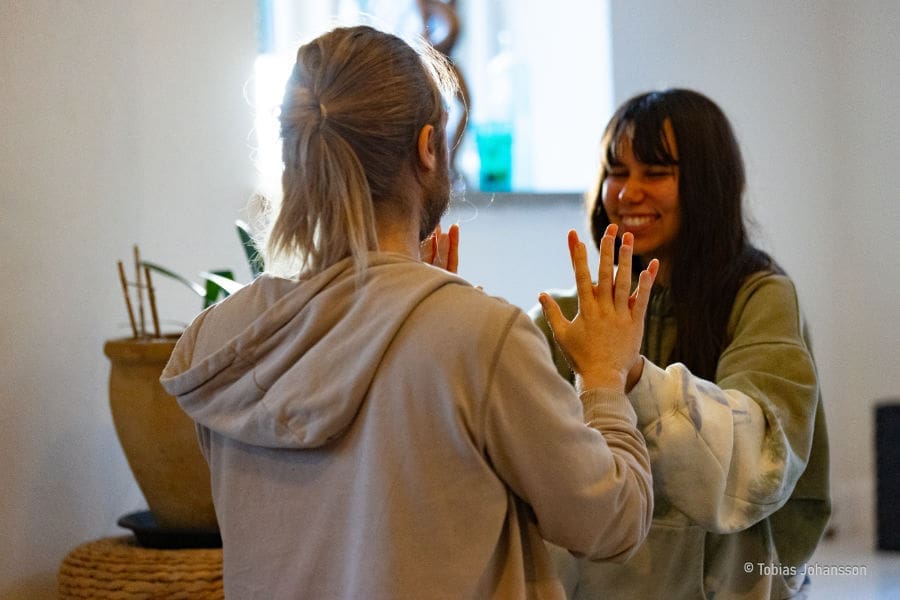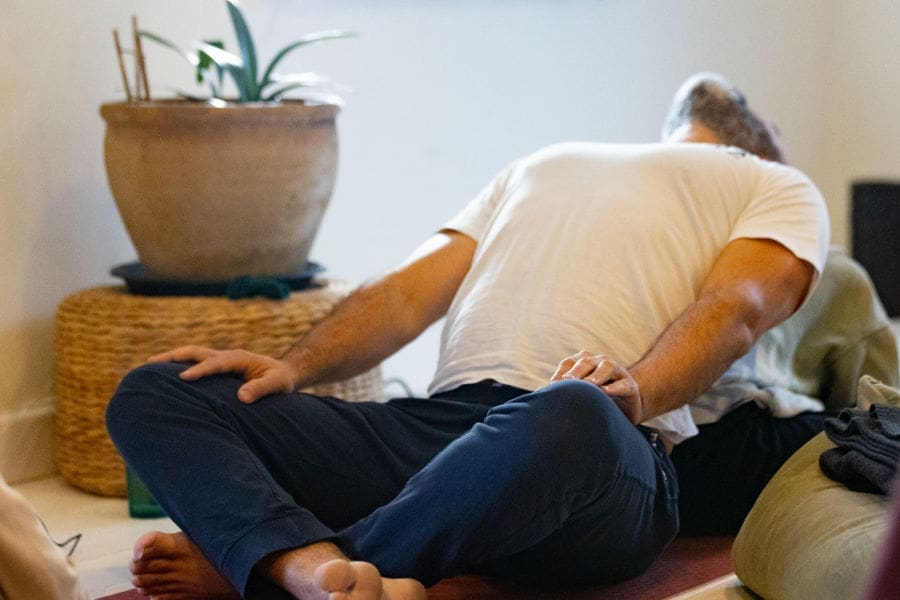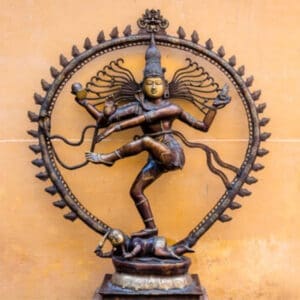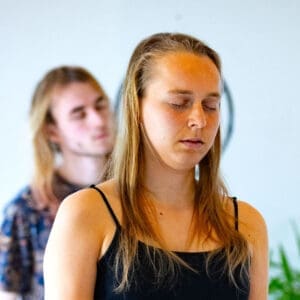tantra is the weaving of body, mind, and spirit
into the fabric of life
tantra yoga
We teach The Path of Love, which draws on the deep wisdom of classical Tantra Yoga. Love is the single unifying principle that can reconcile opposites. This yoga is for those who seek deeper, more authentic connections—with themselves, with others, and with source of life itself.
The Path Of Love
classical tantra yoga
Love is the unifying principle that reconciles opposites. Without love, we see the Universe in terms of polarities and paradoxes. Tantra Yoga is about connecting with universal consciousness, whose principal quality is love.
You are not an isolated fragment lost in an indifferent universe.
Tantra Yoga is often misunderstood as being about sexual practices (see below), when it’s scope is far broader. It is about all of life. Tantra Yoga focuses on achieving balance and healing, helping practitioners dissolve ego-based limitations, and breathes life into relationships, transforming them into profound, soulful connections that transcend ordinariness.
Most people do not lead lives filled with love and happiness, and are often trapped by past emotions, fears, limiting ideas, and social constructs. This sense of entrapment explains the popularity of movies like The Matrix and conspiracy theories about being controlled. These narratives reflect the self-created illusion of reality that is based on fear and a sense of separation.
We teach The Path of Love, which draws from the deep wisdom of the tantras and ancient traditions. These teachings are effective for everyone, even those with busy lives, even if your life is far from what you hoped for. In fact, especially if this is so—an existential crisis has been the inspiration for many to turn their lives around.
Profound connection with self, others, and the world around you is possible. It can lead to love without fear, and happiness for no reason.
Love is the bridge between you and everything.
Rumi
Tantra practices
core elements of tantra yoga
Tantra Yoga practices form a complex system that provides a clear path for personal growth, spiritual development, and self-realization. Practising Tantra Yoga in daily life creates balance, harmony, and connection with yourself, others, and the world around you.
Tantra Yoga practice is not about seeking fleeting pleasures or creating picture-perfect moments for social media. It is for those genuinely curious about following an authentic path of spiritual awakening. It also has very practical benefits, such as improved relationships, more joy and better health.
Here are some of the Tantra Yoga practices we teach at Yogi Living. The exact methods used for any class will depend on the depth of experience and wishes of those present.
1. Cacao Ceremony
A sacred ritual of drinking high grade spiced cacao, meditation, breathwork, and intention setting. Removes emotional blocks, releases stuck emotions, promotes heart opening and intuition.
2. Chakra Yoga
Chakra yoga aims to balance the flow of energy through the energy centers. Removes blockages, raises energy levels, brings greater self-awareness, and improved mental clarity and focus.
3. Tantra Meditation For Couples
A meditation for couples using eye contact and breathing with each other. A tantra practice that deepens emotional connection, intimacy and trust, and deepens self-awareness.
4. Venus Kriyas
Venus Kriyas are short, potent Kundalini Yoga practices done with a partner. Brings balance and harmony to the two partners, and deep connection.
5. Dynamic Meditation
An active meditation with breath work, wild movements, and emotional release. Helps move stagnant energy and break conditioned patterns that keep one imprisoned in the past.
6. Kundalini Meditation
An active meditation to awaken kundalini and balance the chakras. Transforms stagnant energy into bliss and joy, allows the body and mind to release tension, and creates a sense of calm.
7. Tantric Hug
Tantric hugs involve slowing down, being present, and exploring physical touch and breath awareness. These deep hugs create meaningful emotional connection between partners.
8. Sensual Touch
Learn techniques for sensual touch, melting embrace, trantric kissing and tantra massage (no nudity).
9. Tantric Communication
The key elements of tantric communication are mindfulness, non-judgemental active listening, emotional expression and sensory exploration.
10. Tantra Philosophy
11. Tantric Lovemaking
An introduction to tantric love making. We teach the theory of tantric love making as a meeting of souls – without physical contact. Afterwards you can practice with your partner.
Tantra Yoga practices form a comprehensive system aimed at self-realization, and the harmonious integration of body, mind, and spirit. The guidance of a experienced teacher is essential for deepening tantric practice and ensuring correct application of techniques.


Neo-Tantra And Classical Tantra
tantra is NOT about sex
Emerging in the 20th century when scholars like Sir John Woodroffe translated a small number of Tantric texts, Neo-Tantra is presented as a fusion of ancient spiritual teachings and contemporary Western ideas. With its limited focus on sexuality and intimacy it is quite unlike Classical Tantra, which encompasses a vast spiritual framework including meditation, rituals, and philosophy, not to mention millennia of practice.
Neo-Tantra and Classical Tantra share little beyond the name and a belief that sexuality doesn’t have to be separate from spirituality.
While Neo-Tantra has brought awareness to ancient spiritual practices and encouraged open discussions about intimacy and energy, it also has notable drawbacks:
- Oversimplification of Traditional Tantra: Neo-Tantra often reduces classical Tantra to a focus on sexuality, neglecting its broader spiritual dimensions.
- Commercialization: Many Neo-Tantra workshops and retreats are marketed with a focus on sexual allure, turning sacred practices into commodities. This commercialization can exploit vulnerable individuals who are genuinely seeking spiritual growth or healing.
- Lack of Authenticity: Inadequate training or knowledge among many practitioners and teachers can result in misguided practices or misinformation, diminishing the integrity of the teachings.
- Boundary Issues: The nature of the workshops and inexperience of Neo-Tantra teachers and participants has lead to lack of respect for personal boundaries and unethical behavior, particularly in teacher-student dynamics, where power imbalances exist.
- Focus on Ego Gratification: Neo-Tantra’s emphasis on personal pleasure can overshadow its spiritual intent, turning it into a self-serving pursuit rather than a path to transcendence and connection.
Working with sexual energy requires careful balance as the energies released are very strong and can be attached to deep personal trauma. An experienced teacher is essential.
Trying to distill what should be a lifetime of practice into a short weekend retreat, Neo-Tantra workshops have become little more than pick-and-mix commodities in a growing conscious sexuality marketplace. Such retreats can have benefits, but are a magnet for narcissists and sexual predators. The allure of “sacred sex” workshops can be compelling, but should be approached with caution or avoided altogether if personal boundaries are not respected.
By taking a more holistic approach Classical Tantra Yoga integrates sexual polarities with meditation, breathwork and activating the chakras, helping to balance and safely diffuse suppressed emotions. And let’s not forget the tremendously soothing and calming effect of love energy practices.
Read more in our blog post: Classical Tantra Is Not About Sex!

Tantra Yoga Past To Present
connecting the dots
Classical Tantra Yoga is a spiritual tradition that began in India and thrived between the 5th and 12th centuries. During this time, thousands of texts known as “Tantras” were written, many of which are yet to be translated. The texts detail Tantric practices and philosophy. The main aim of these practices and beliefs is to raise consciousness, explore the nature of reality, and achieve spiritual liberation.
The tantric practices spread across India and further east into Tibet and Nepal, as well as to south asia. During this time, Tantra Yoga merged with many spiritual traditions, in particular Tibetan Buddhism and Taoism.
The tradition was vibrant in the region of North India known as Kashmir. Much of what is understood today about the Classical Tantra Yoga tradition comes from this area and is now referred to as Kashmir Shaivism, which embodies the Tantric teachings of Shiva and Shakti.
The Vigyan Bhairav Tantra
The Vigyan Bhairav Tantra is the most frequently cited tantric text and is rooted in Kashmiri Shaivism, a tradition dedicated to the worship of Lord Shiva. The title translates to “Knowledge of Divine Awareness,” with Vigyan meaning knowledge, Bhairav referring to the transcendental aspect of Shiva.
The text takes the form of a dialogue between Lord Shiva and his consort, Goddess Parvati. Parvati poses existential questions about the nature of reality and the path to liberation, to which Shiva responds by revealing methods to achieve this. The techniques are highly diverse, and include breath control, sensory awareness, visualization, and focus on everyday experiences that can be used to access deeper states of awareness.
Within the passages of the Vigyan Bhairav Tantra are 112 gateways to samadhi, or methods for attaining higher states of consciousness. The methods emphasize direct personal experience over ritual or beliefs. It encourages practitioners to find divinity in the present moment and within themselves.
It is worth noting that only 3 of the 112 methods could be described as being of a sexual nature. Tantra is NOT about sex! It is about all of life.
The Connection to Modern Yoga
Much of what is recognized today as yoga has direct or indirect roots in Tantric techniques and principles. Traditions such as Kundalini yoga, Mantra yoga, Hatha yoga, and Kriya yoga all emerged from Tantra yoga.
Understanding this lineage explains why so many yoga styles use elements such as breath control, meditation, and energy work—which are all hallmarks of Tantra Yoga. Tantra Yoga is not some quirky offshoot of yoga but is, in fact, one of the most important lineages.
Tantra teaches us to dissolve the barriers of separation and experience the unity that lies at the heart of all existence.
Christopher Wallis
Yoga from the heart
feel the love
We teach yoga from the heart. We believe laughter is as much a part of yoga as deep silence, and we work to create deep connections. The aim is to raise consciousness and ultimately help you achieve liberation. This is the meaning of tantra for us.
Key to our approach is working with the chakras, which facilitates elevation in love and depth in meditation. Using Tantra Yoga we work on different elements (koshas) of your being, including the physical, energetic, emotional, mental, and spiritual bodies. Each requires its own approach and needs to be integrated with the others.
Our practices are designed to be releasing, heartwarming, and deeply meditative. When you leave a retreat, you will not be the same person. Indeed, you will be able to experience heart-centred living and communication! Regular practice of Tantra Yoga can bring you to better health and create the kind of relationships you know are possible – but perhaps have struggled to find.
Experience the freedom, joy and lightness that comes through classical tantra yoga! Whether you are an experienced yogi or a complete beginner you will leave here with a smile and friendships that last a lifetime.

Joyful Living
living with tantra practice
Tantra Yoga works with the whole body and the whole person. Tantra practices work on all five bodies (known as koshas): physical, energetic, mental, emotional, and spiritual. When we bring awareness to each, we stop living unconsciously and gain control over our desires and actions.
Here are 9 life-changing benefits of Tantra Yoga practice:
1. Holistic Wellbeing
Tantra Yoga practices promote overall wellbeing by addressing all aspects of a person’s life—physical, emotional, mental, and spiritual. The integration of different practices creates balance and harmony within and with the outer world.
2. Greater Self-Awareness
Through meditation, and mindful practices Tantra practices help cultivate a deep sense of self. This increased awareness helps you understand thoughts, emotions, and behaviors better, leading to greater self-control and personal growth.
3. Emotional Healing
The meditative and breathing techniques in Tantra Yoga are effective in reducing stress and anxiety. By focusing on the present moment practitioners release pent-up emotions and undergo deep emotional healing.
4. Better Health
Tantra Yoga asanas improve flexibility, strength, and stamina. Also, pranayama practices improve respiratory health, promoting overall vitality.
5. More Energy
Tantra Yoga practices work with the body’s energy systems, particularly the chakras and nadis. By clearing and balancing the energy centers, you can experience increased vitality, mental clarity, and emotional stability.
6. Intimacy And Connection
Tantra Yoga practices develop an appreciation of the body, your own and that of others. A natural result of this is healthier, more respectful, and intimate relationships. Tantra Yoga also encourages the expression of love and compassion, which deepens your connection with others.
7. Improved Focus
Tantra Yoga practices, such as concentration on mantras, and meditation, help improve mental clarity and concentration. This improves productivity and efficiency both in daily tasks and your profession.
8. Personal Empowerment
By helping you realize your strength and potential, and by overcoming limiting beliefs and fears, Tantra Yoga helps you develop greater confidence.
9. Inner Peace And Joy
Ultimately, Tantra Yoga practices create deep inner peace and joy. With dedicated practice a profound sense of contentment and fulfillment arises, and one that is independent of external circumstances.
Tantra Yoga practices are a comprehensive approach to self-discovery and personal growth. The benefits go far beyond the physical to include emotional healing, spiritual awakening, and a profound connection with self and the world. They are a valuable tool for those seeking a deeper understanding of life and a more balanced, joyful way to live.
Tantra For Couples (4 days)
the yoga of love
“Tantra is not just about the union of two bodies, but the union of two souls”
Ask Winnie
frequently asked questions
What is classical tantra yoga?
Classical Tantra Yoga is a spiritual tradition that began in India and thrived between the 5th and 12th centuries. During this time, thousands of texts known as “Tantras” were written. The texts detailed various Tantric practices and included many long commentaries. The primary aim of these yogic practices and beliefs was to elevate consciousness, explore the nature of reality, and achieve spiritual liberation.
What is neo-tantra?
Neo-Tantra and Classical Tantra differ significantly in their focus and practices. Neo-Tantra primarily emphasizes sexual liberation and the concept of sacred sex. In Classical Tantra, sexuality is seen as only one aspect of the human experience that can serve a spiritual practice.
Neo-Tantra and Classical Tantra share little beyond their name and the belief that sexuality doesn’t have to be separate from spirituality.
Do I need yoga experience?
Not at all. Yoga classes are optional and tailored to individual needs, without the complicated postures you may see online.
Are classes held in English?
Yogi Living Retreat Center resident yoga teacher Winnie Winnetu speaks English, Swedish, Danish, French and German so don’t worry if you cannot speak Swedish!
How do I get to Yogi Living Retreat Center?
Yogi Living Retreat Center is located in Skåne, South Sweden close to the vibrant city of Malmö. The closest international airports are Copenhagen Airport, Kastrup (75 km) and Malmö airport, Sturup (30 km) with good rail connections to Malmö and on to Trelleborg (our closest town). You can also come by car through Germany and take the ferry from Rostock to Trelleborg. There are 3 sailings (6 hours duration) per day.
We can pick you up by car from Malmö or Trelleborg, but please ask for this in advance.
What is the local area like?
The surrounding countryside is picture-postcard Sweden. There are many small picturesque villages and a mixture of open farmland, woodland, and lakes. The wonderful coastline of the Swedish Riviera is only 5km away. When the weather allows we can arrange an excursion to places like the Ales Stones (the “Swedish Stonehenge”) and local castles.
You can also hang out in the garden where we have a treehouse meditation platform and a jacuzzi. There is a small ICA supermarket 5 minutes walk from the ashram.
Can I call you?
You can send a message through the website here.
You are also welcome to contact me directly by phone (+46) 730-702785.
Let's Talk
we would love to hear from you!
Discovery Call
A discovery call is a chance to talk about what you’re looking for. It’s relaxed and informal, and all about understanding how I can support you.
Ask A Question
Book a discovery call with Winnie to see if we are a good fit for you. Or simply ask a question by email, and we will get back to you as soon as we can!


